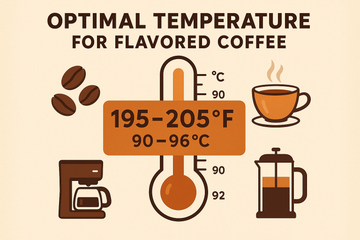Master the art of temperature control to unlock the full potential of your flavored coffee blends. Discover how precise brewing temperatures enhance vanilla, caramel, and floral notes for an exceptional coffee experience.
Temperature control stands as one of the most critical factors in brewing exceptional flavored coffee. Unlike traditional coffee varieties, flavored blends require specific temperature considerations to properly extract both the coffee's natural compounds and the delicate flavor profiles that make each cup unique. Understanding these temperature nuances can transform your daily brewing routine from ordinary to extraordinary.
Understanding Temperature's Impact on Flavored Coffee
The relationship between water temperature and flavor extraction in coffee is complex, becoming even more intricate when dealing with flavored varieties. Water that's too hot can over-extract bitter compounds while simultaneously destroying delicate flavor oils. Conversely, water that's too cool fails to properly extract the coffee's essential oils and may leave flavored elements underdeveloped.
Flavored coffees typically contain natural or artificial flavor compounds that respond differently to heat compared to standard coffee beans. These flavor elements often have lower volatility points, meaning they can be damaged or altered by excessive heat. This characteristic makes temperature precision absolutely crucial for achieving the intended taste profile.
Optimal Temperature Ranges for Different Flavor Profiles
Vanilla and Sweet Flavors
Vanilla-flavored coffees perform exceptionally well at slightly lower temperatures than traditional coffee. The optimal brewing temperature for vanilla blends ranges from 190°F to 195°F. This temperature range allows the vanilla compounds to integrate smoothly with the coffee's natural sweetness without becoming overpowering or artificial-tasting.
Sweet flavor profiles, including caramel, butterscotch, and toffee varieties, benefit from similar temperature considerations. These flavors contain sugar-based compounds that can caramelize or burn at higher temperatures, creating unwanted bitter notes that mask the intended sweetness.
Floral and Delicate Notes
Floral coffee varieties require the most careful temperature management. Jasmine, rose, lavender, and other floral notes are extremely heat-sensitive and can become soapy or medicinal when exposed to excessive heat. For these delicate profiles, maintain brewing temperatures between 185°F and 190°F.
The lower temperature range preserves the subtle aromatic compounds that give floral coffees their distinctive character. This approach requires slightly longer brewing times to achieve proper extraction, but the resulting cup showcases the intended floral complexity without harsh or off-putting notes.
Fruit and Citrus Flavors
Fruit-flavored coffees, particularly those with citrus notes, can handle slightly higher temperatures than floral varieties but still require moderation. Berry, cherry, orange, and lemon flavored coffees perform best at temperatures between 190°F and 200°F.
The natural acidity in fruit flavors can complement coffee's inherent acidity when properly extracted. However, excessive heat can create an unbalanced cup where artificial fruit flavors dominate the coffee's natural characteristics.
Spice and Nut Flavors
Spiced coffees, including cinnamon, nutmeg, and cardamom varieties, along with nut-flavored options like hazelnut and almond, can tolerate higher brewing temperatures. These robust flavor profiles work well with temperatures ranging from 195°F to 205°F.
The oils and compounds in spice and nut flavors are generally more heat-stable, allowing for traditional brewing temperatures while still maintaining flavor integrity. These varieties often benefit from the fuller extraction that higher temperatures provide.
Brewing Method Considerations
Drip Coffee Makers
Most automatic drip coffee makers heat water to approximately 200°F, which may be too hot for delicate flavored coffees. If your machine lacks temperature control, consider allowing the water to cool for 30-60 seconds after the brewing cycle completes before it contacts the coffee grounds.
For machines with temperature settings, adjust according to your specific flavor profile. Many newer models offer precise temperature control that makes brewing flavored coffee much more manageable.
Pour-Over Methods
Pour-over brewing provides excellent temperature control for flavored coffees. Heat water to your target temperature using a thermometer, then maintain consistency throughout the brewing process. The manual control allows for precise temperature management that automated systems cannot match.
Consider using a gooseneck kettle with built-in temperature control for the most consistent results. This equipment investment pays dividends in cup quality, particularly for temperature-sensitive flavored varieties.
French Press
French press brewing works well for flavored coffees when temperature is properly managed. The immersion method allows flavors to develop fully at lower temperatures, making it ideal for delicate profiles. Use the appropriate temperature for your flavor type and extend steeping time by 30-60 seconds to compensate for lower heat.
Espresso Preparation
Espresso machines typically operate at higher temperatures and pressures, which can be challenging for flavored coffees. If possible, reduce your machine's brewing temperature by 5-10 degrees when preparing flavored shots. The concentrated nature of espresso can intensify both positive and negative flavor characteristics.
Measuring and Maintaining Temperature
Accurate temperature measurement is essential for consistent results. Invest in a reliable instant-read thermometer or a kettle with built-in temperature display. Digital thermometers provide the precision necessary for optimal flavored coffee brewing.
Remember that water temperature drops quickly once removed from heat. Factor in this cooling when timing your brewing process. Water typically loses 5-10 degrees within the first minute after reaching peak temperature.
Additional Temperature Tips
Preheating your brewing equipment helps maintain consistent temperature throughout the process. Rinse your dripper, carafe, or French press with hot water before adding coffee grounds. This simple step prevents temperature shock that can affect extraction.
Consider your serving temperature as well. Flavored coffees often taste best when served slightly cooler than traditional coffee, around 140°F to 150°F. This temperature range allows the flavor compounds to present themselves without being masked by excessive heat.
Grind size also interacts with temperature in flavored coffee brewing. Finer grinds extract more quickly and may require slightly lower temperatures to prevent over-extraction. Coarser grinds can handle higher temperatures and may need them to achieve proper extraction.
Troubleshooting Temperature Issues
If your flavored coffee tastes artificial or overpowering, your brewing temperature may be too high. Reduce the temperature by 5-10 degrees and adjust brewing time accordingly. Conversely, if flavors seem muted or underdeveloped, gradually increase temperature while monitoring taste changes.
Bitter or harsh flavors often indicate over-extraction caused by excessive heat. Sour or weak flavors typically suggest under-extraction from insufficient temperature. Fine-tune your approach based on these taste indicators.
Keep detailed notes about temperature settings and results for different flavored coffee varieties. This record helps you replicate successful brews and avoid repeating mistakes. Each flavored coffee may have slightly different optimal parameters, making documentation valuable for consistent results.
Mastering temperature control for flavored coffee brewing requires patience and experimentation, but the results justify the effort. By understanding how different flavor profiles respond to heat and adjusting your technique accordingly, you can unlock the full potential of every flavored coffee variety in your collection.






